Alberta Union of Provincial Employees (AUPE): Labour Relations Report
VerifiedAdded on 2020/03/23
|6
|1475
|79
Report
AI Summary
This report provides an overview of the Alberta Union of Provincial Employees (AUPE), a prominent labour relations union in Alberta representing over 90,000 members. It traces the AUPE's history from its inception in 1919 as the Civil Service Association of Alberta (CSAA) to its current status, highlighting significant events such as strikes in the 1970s, challenges in the 1980s, and campaigns for labor law reform. The report discusses the AUPE's current focus on education, awareness, pensions, and collective bargaining, emphasizing its role in advocating for its members and addressing employment issues such as gender equality and discrimination. The report concludes with a personal reflection on the benefits of union membership.
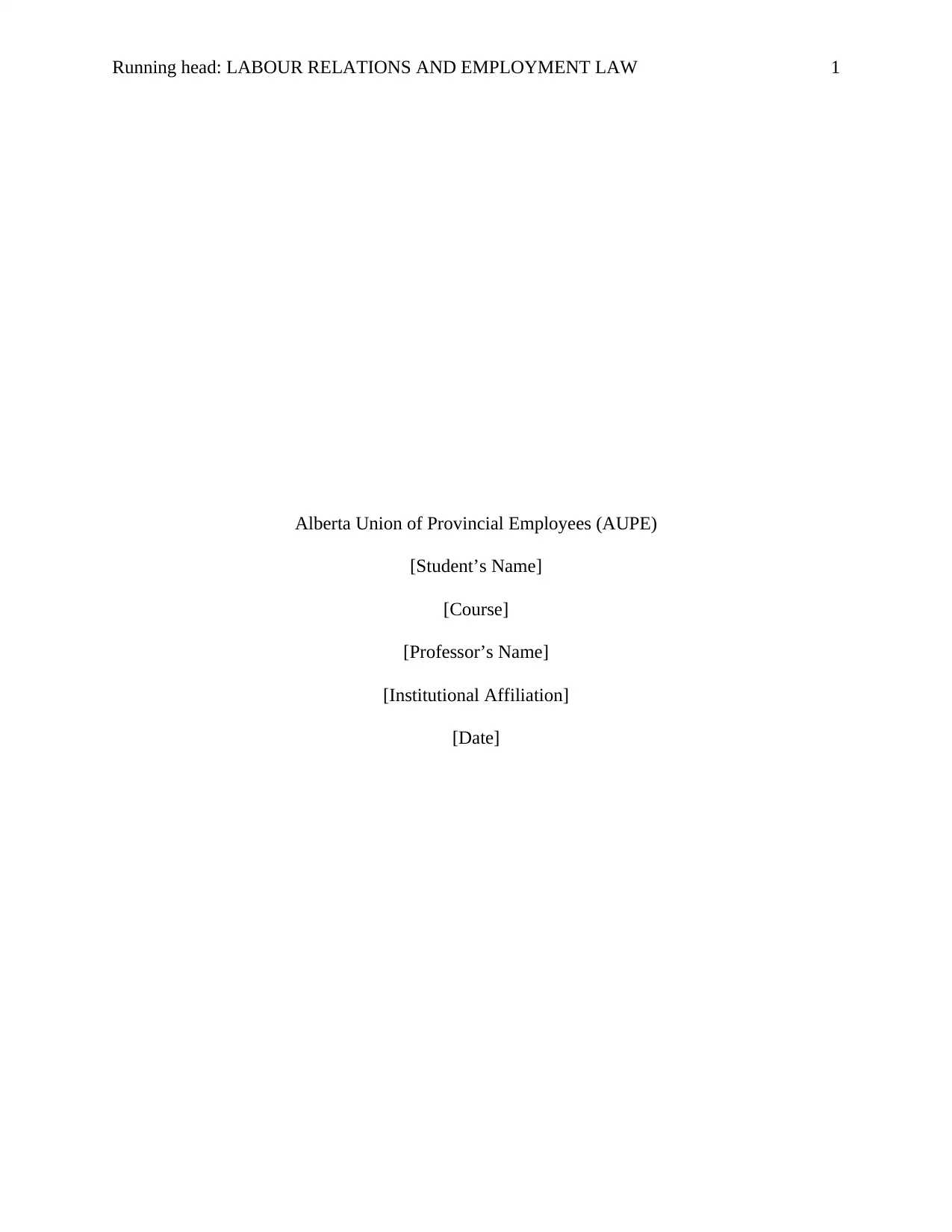
Running head: LABOUR RELATIONS AND EMPLOYMENT LAW 1
Alberta Union of Provincial Employees (AUPE)
[Student’s Name]
[Course]
[Professor’s Name]
[Institutional Affiliation]
[Date]
Alberta Union of Provincial Employees (AUPE)
[Student’s Name]
[Course]
[Professor’s Name]
[Institutional Affiliation]
[Date]
Paraphrase This Document
Need a fresh take? Get an instant paraphrase of this document with our AI Paraphraser
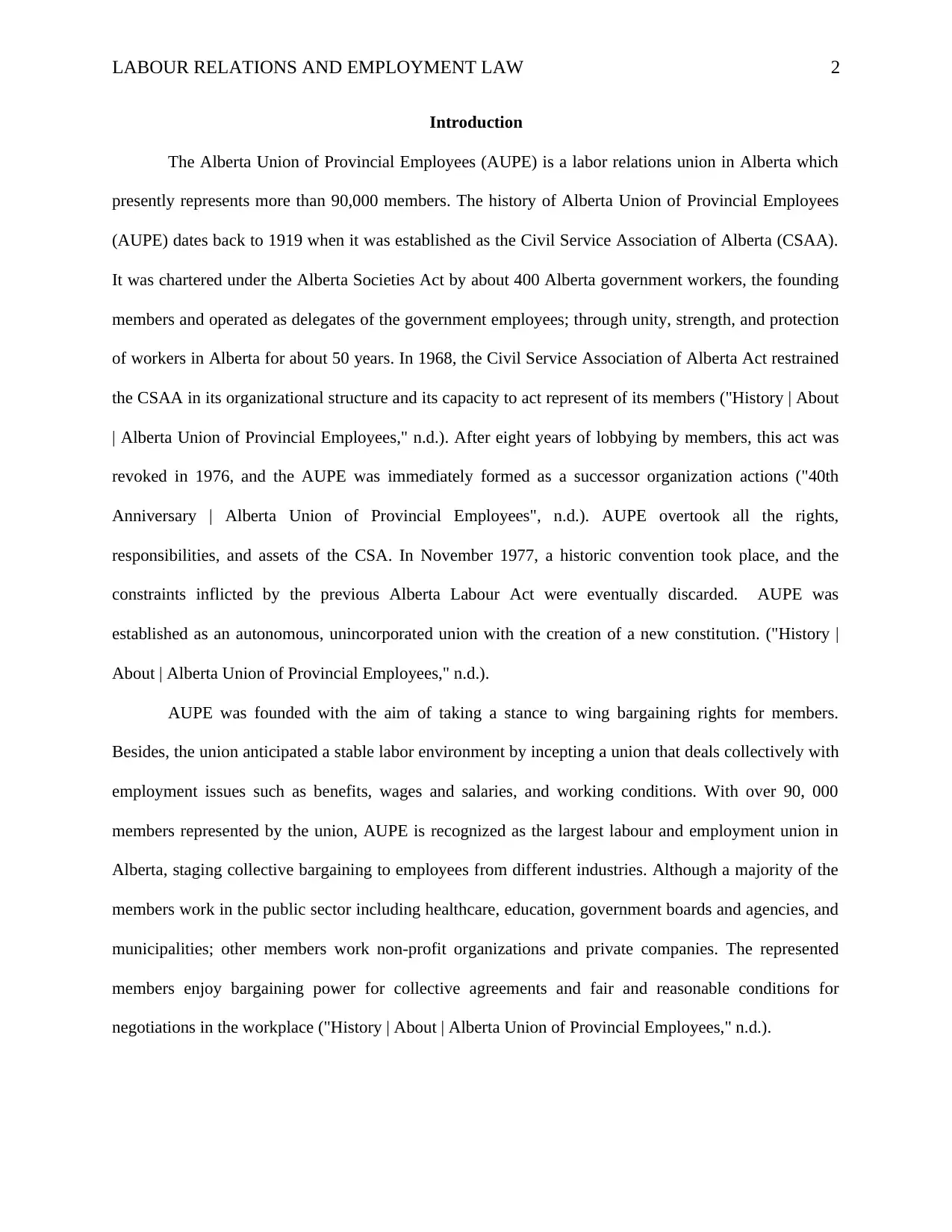
LABOUR RELATIONS AND EMPLOYMENT LAW 2
Introduction
The Alberta Union of Provincial Employees (AUPE) is a labor relations union in Alberta which
presently represents more than 90,000 members. The history of Alberta Union of Provincial Employees
(AUPE) dates back to 1919 when it was established as the Civil Service Association of Alberta (CSAA).
It was chartered under the Alberta Societies Act by about 400 Alberta government workers, the founding
members and operated as delegates of the government employees; through unity, strength, and protection
of workers in Alberta for about 50 years. In 1968, the Civil Service Association of Alberta Act restrained
the CSAA in its organizational structure and its capacity to act represent of its members ("History | About
| Alberta Union of Provincial Employees," n.d.). After eight years of lobbying by members, this act was
revoked in 1976, and the AUPE was immediately formed as a successor organization actions ("40th
Anniversary | Alberta Union of Provincial Employees", n.d.). AUPE overtook all the rights,
responsibilities, and assets of the CSA. In November 1977, a historic convention took place, and the
constraints inflicted by the previous Alberta Labour Act were eventually discarded. AUPE was
established as an autonomous, unincorporated union with the creation of a new constitution. ("History |
About | Alberta Union of Provincial Employees," n.d.).
AUPE was founded with the aim of taking a stance to wing bargaining rights for members.
Besides, the union anticipated a stable labor environment by incepting a union that deals collectively with
employment issues such as benefits, wages and salaries, and working conditions. With over 90, 000
members represented by the union, AUPE is recognized as the largest labour and employment union in
Alberta, staging collective bargaining to employees from different industries. Although a majority of the
members work in the public sector including healthcare, education, government boards and agencies, and
municipalities; other members work non-profit organizations and private companies. The represented
members enjoy bargaining power for collective agreements and fair and reasonable conditions for
negotiations in the workplace ("History | About | Alberta Union of Provincial Employees," n.d.).
Introduction
The Alberta Union of Provincial Employees (AUPE) is a labor relations union in Alberta which
presently represents more than 90,000 members. The history of Alberta Union of Provincial Employees
(AUPE) dates back to 1919 when it was established as the Civil Service Association of Alberta (CSAA).
It was chartered under the Alberta Societies Act by about 400 Alberta government workers, the founding
members and operated as delegates of the government employees; through unity, strength, and protection
of workers in Alberta for about 50 years. In 1968, the Civil Service Association of Alberta Act restrained
the CSAA in its organizational structure and its capacity to act represent of its members ("History | About
| Alberta Union of Provincial Employees," n.d.). After eight years of lobbying by members, this act was
revoked in 1976, and the AUPE was immediately formed as a successor organization actions ("40th
Anniversary | Alberta Union of Provincial Employees", n.d.). AUPE overtook all the rights,
responsibilities, and assets of the CSA. In November 1977, a historic convention took place, and the
constraints inflicted by the previous Alberta Labour Act were eventually discarded. AUPE was
established as an autonomous, unincorporated union with the creation of a new constitution. ("History |
About | Alberta Union of Provincial Employees," n.d.).
AUPE was founded with the aim of taking a stance to wing bargaining rights for members.
Besides, the union anticipated a stable labor environment by incepting a union that deals collectively with
employment issues such as benefits, wages and salaries, and working conditions. With over 90, 000
members represented by the union, AUPE is recognized as the largest labour and employment union in
Alberta, staging collective bargaining to employees from different industries. Although a majority of the
members work in the public sector including healthcare, education, government boards and agencies, and
municipalities; other members work non-profit organizations and private companies. The represented
members enjoy bargaining power for collective agreements and fair and reasonable conditions for
negotiations in the workplace ("History | About | Alberta Union of Provincial Employees," n.d.).
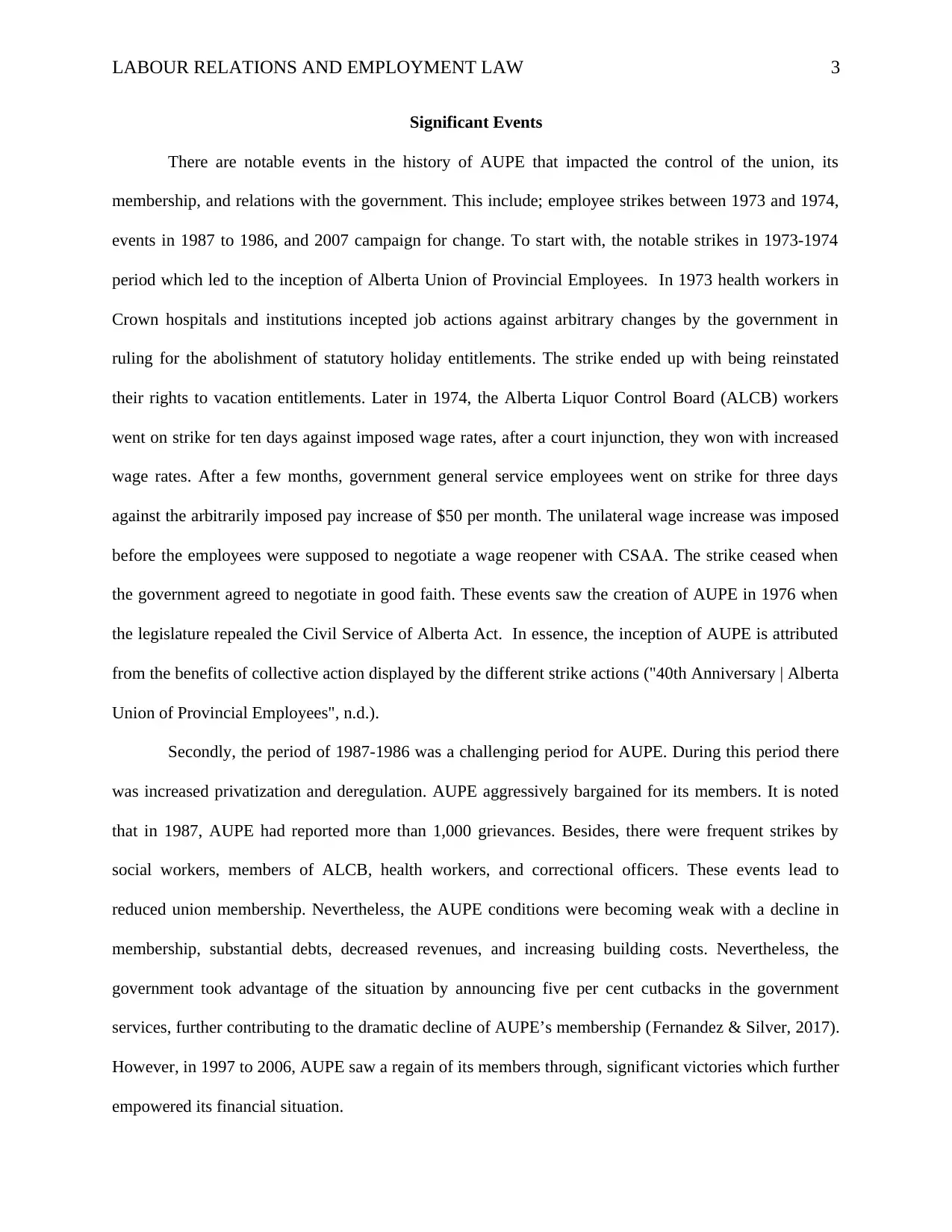
LABOUR RELATIONS AND EMPLOYMENT LAW 3
Significant Events
There are notable events in the history of AUPE that impacted the control of the union, its
membership, and relations with the government. This include; employee strikes between 1973 and 1974,
events in 1987 to 1986, and 2007 campaign for change. To start with, the notable strikes in 1973-1974
period which led to the inception of Alberta Union of Provincial Employees. In 1973 health workers in
Crown hospitals and institutions incepted job actions against arbitrary changes by the government in
ruling for the abolishment of statutory holiday entitlements. The strike ended up with being reinstated
their rights to vacation entitlements. Later in 1974, the Alberta Liquor Control Board (ALCB) workers
went on strike for ten days against imposed wage rates, after a court injunction, they won with increased
wage rates. After a few months, government general service employees went on strike for three days
against the arbitrarily imposed pay increase of $50 per month. The unilateral wage increase was imposed
before the employees were supposed to negotiate a wage reopener with CSAA. The strike ceased when
the government agreed to negotiate in good faith. These events saw the creation of AUPE in 1976 when
the legislature repealed the Civil Service of Alberta Act. In essence, the inception of AUPE is attributed
from the benefits of collective action displayed by the different strike actions ("40th Anniversary | Alberta
Union of Provincial Employees", n.d.).
Secondly, the period of 1987-1986 was a challenging period for AUPE. During this period there
was increased privatization and deregulation. AUPE aggressively bargained for its members. It is noted
that in 1987, AUPE had reported more than 1,000 grievances. Besides, there were frequent strikes by
social workers, members of ALCB, health workers, and correctional officers. These events lead to
reduced union membership. Nevertheless, the AUPE conditions were becoming weak with a decline in
membership, substantial debts, decreased revenues, and increasing building costs. Nevertheless, the
government took advantage of the situation by announcing five per cent cutbacks in the government
services, further contributing to the dramatic decline of AUPE’s membership (Fernandez & Silver, 2017).
However, in 1997 to 2006, AUPE saw a regain of its members through, significant victories which further
empowered its financial situation.
Significant Events
There are notable events in the history of AUPE that impacted the control of the union, its
membership, and relations with the government. This include; employee strikes between 1973 and 1974,
events in 1987 to 1986, and 2007 campaign for change. To start with, the notable strikes in 1973-1974
period which led to the inception of Alberta Union of Provincial Employees. In 1973 health workers in
Crown hospitals and institutions incepted job actions against arbitrary changes by the government in
ruling for the abolishment of statutory holiday entitlements. The strike ended up with being reinstated
their rights to vacation entitlements. Later in 1974, the Alberta Liquor Control Board (ALCB) workers
went on strike for ten days against imposed wage rates, after a court injunction, they won with increased
wage rates. After a few months, government general service employees went on strike for three days
against the arbitrarily imposed pay increase of $50 per month. The unilateral wage increase was imposed
before the employees were supposed to negotiate a wage reopener with CSAA. The strike ceased when
the government agreed to negotiate in good faith. These events saw the creation of AUPE in 1976 when
the legislature repealed the Civil Service of Alberta Act. In essence, the inception of AUPE is attributed
from the benefits of collective action displayed by the different strike actions ("40th Anniversary | Alberta
Union of Provincial Employees", n.d.).
Secondly, the period of 1987-1986 was a challenging period for AUPE. During this period there
was increased privatization and deregulation. AUPE aggressively bargained for its members. It is noted
that in 1987, AUPE had reported more than 1,000 grievances. Besides, there were frequent strikes by
social workers, members of ALCB, health workers, and correctional officers. These events lead to
reduced union membership. Nevertheless, the AUPE conditions were becoming weak with a decline in
membership, substantial debts, decreased revenues, and increasing building costs. Nevertheless, the
government took advantage of the situation by announcing five per cent cutbacks in the government
services, further contributing to the dramatic decline of AUPE’s membership (Fernandez & Silver, 2017).
However, in 1997 to 2006, AUPE saw a regain of its members through, significant victories which further
empowered its financial situation.
⊘ This is a preview!⊘
Do you want full access?
Subscribe today to unlock all pages.

Trusted by 1+ million students worldwide
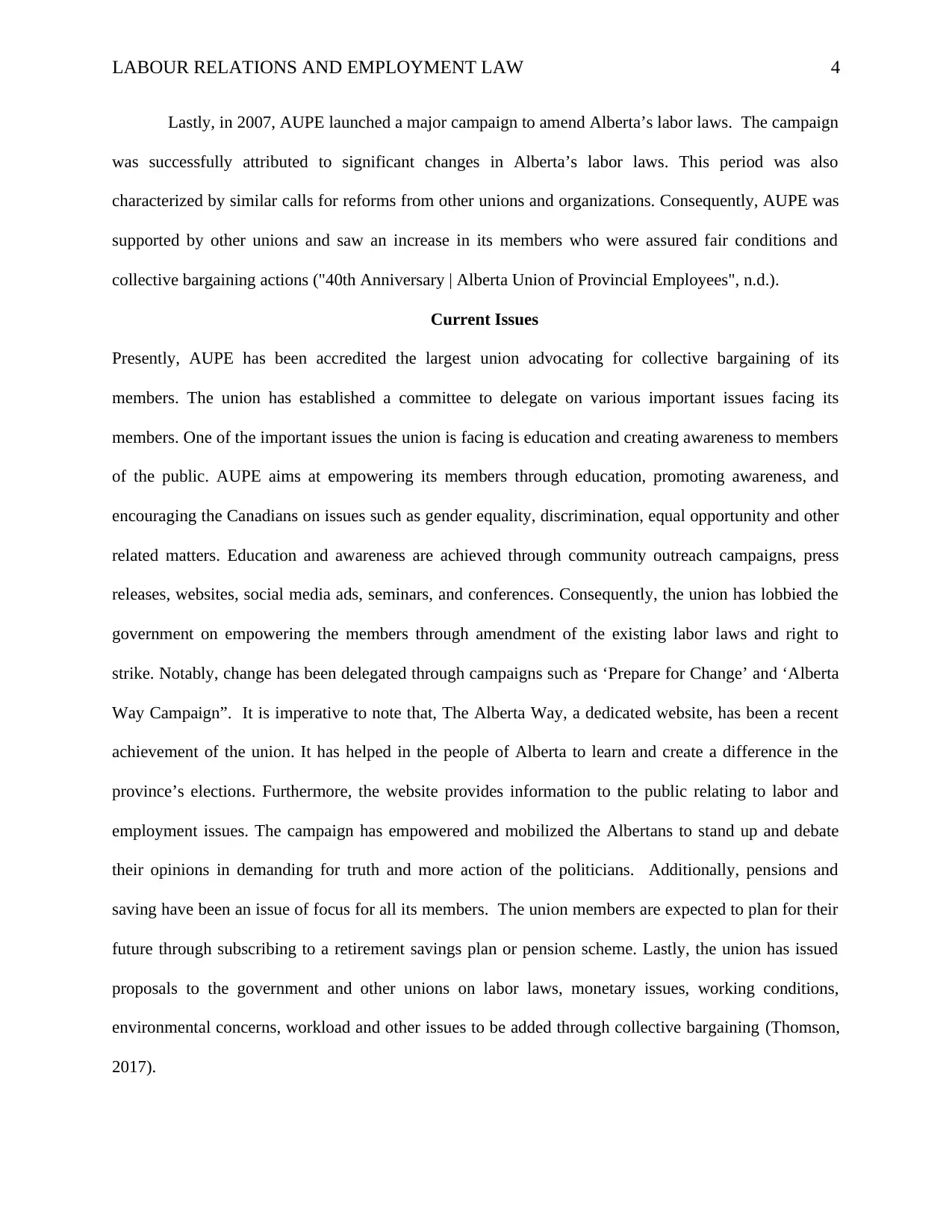
LABOUR RELATIONS AND EMPLOYMENT LAW 4
Lastly, in 2007, AUPE launched a major campaign to amend Alberta’s labor laws. The campaign
was successfully attributed to significant changes in Alberta’s labor laws. This period was also
characterized by similar calls for reforms from other unions and organizations. Consequently, AUPE was
supported by other unions and saw an increase in its members who were assured fair conditions and
collective bargaining actions ("40th Anniversary | Alberta Union of Provincial Employees", n.d.).
Current Issues
Presently, AUPE has been accredited the largest union advocating for collective bargaining of its
members. The union has established a committee to delegate on various important issues facing its
members. One of the important issues the union is facing is education and creating awareness to members
of the public. AUPE aims at empowering its members through education, promoting awareness, and
encouraging the Canadians on issues such as gender equality, discrimination, equal opportunity and other
related matters. Education and awareness are achieved through community outreach campaigns, press
releases, websites, social media ads, seminars, and conferences. Consequently, the union has lobbied the
government on empowering the members through amendment of the existing labor laws and right to
strike. Notably, change has been delegated through campaigns such as ‘Prepare for Change’ and ‘Alberta
Way Campaign”. It is imperative to note that, The Alberta Way, a dedicated website, has been a recent
achievement of the union. It has helped in the people of Alberta to learn and create a difference in the
province’s elections. Furthermore, the website provides information to the public relating to labor and
employment issues. The campaign has empowered and mobilized the Albertans to stand up and debate
their opinions in demanding for truth and more action of the politicians. Additionally, pensions and
saving have been an issue of focus for all its members. The union members are expected to plan for their
future through subscribing to a retirement savings plan or pension scheme. Lastly, the union has issued
proposals to the government and other unions on labor laws, monetary issues, working conditions,
environmental concerns, workload and other issues to be added through collective bargaining (Thomson,
2017).
Lastly, in 2007, AUPE launched a major campaign to amend Alberta’s labor laws. The campaign
was successfully attributed to significant changes in Alberta’s labor laws. This period was also
characterized by similar calls for reforms from other unions and organizations. Consequently, AUPE was
supported by other unions and saw an increase in its members who were assured fair conditions and
collective bargaining actions ("40th Anniversary | Alberta Union of Provincial Employees", n.d.).
Current Issues
Presently, AUPE has been accredited the largest union advocating for collective bargaining of its
members. The union has established a committee to delegate on various important issues facing its
members. One of the important issues the union is facing is education and creating awareness to members
of the public. AUPE aims at empowering its members through education, promoting awareness, and
encouraging the Canadians on issues such as gender equality, discrimination, equal opportunity and other
related matters. Education and awareness are achieved through community outreach campaigns, press
releases, websites, social media ads, seminars, and conferences. Consequently, the union has lobbied the
government on empowering the members through amendment of the existing labor laws and right to
strike. Notably, change has been delegated through campaigns such as ‘Prepare for Change’ and ‘Alberta
Way Campaign”. It is imperative to note that, The Alberta Way, a dedicated website, has been a recent
achievement of the union. It has helped in the people of Alberta to learn and create a difference in the
province’s elections. Furthermore, the website provides information to the public relating to labor and
employment issues. The campaign has empowered and mobilized the Albertans to stand up and debate
their opinions in demanding for truth and more action of the politicians. Additionally, pensions and
saving have been an issue of focus for all its members. The union members are expected to plan for their
future through subscribing to a retirement savings plan or pension scheme. Lastly, the union has issued
proposals to the government and other unions on labor laws, monetary issues, working conditions,
environmental concerns, workload and other issues to be added through collective bargaining (Thomson,
2017).
Paraphrase This Document
Need a fresh take? Get an instant paraphrase of this document with our AI Paraphraser
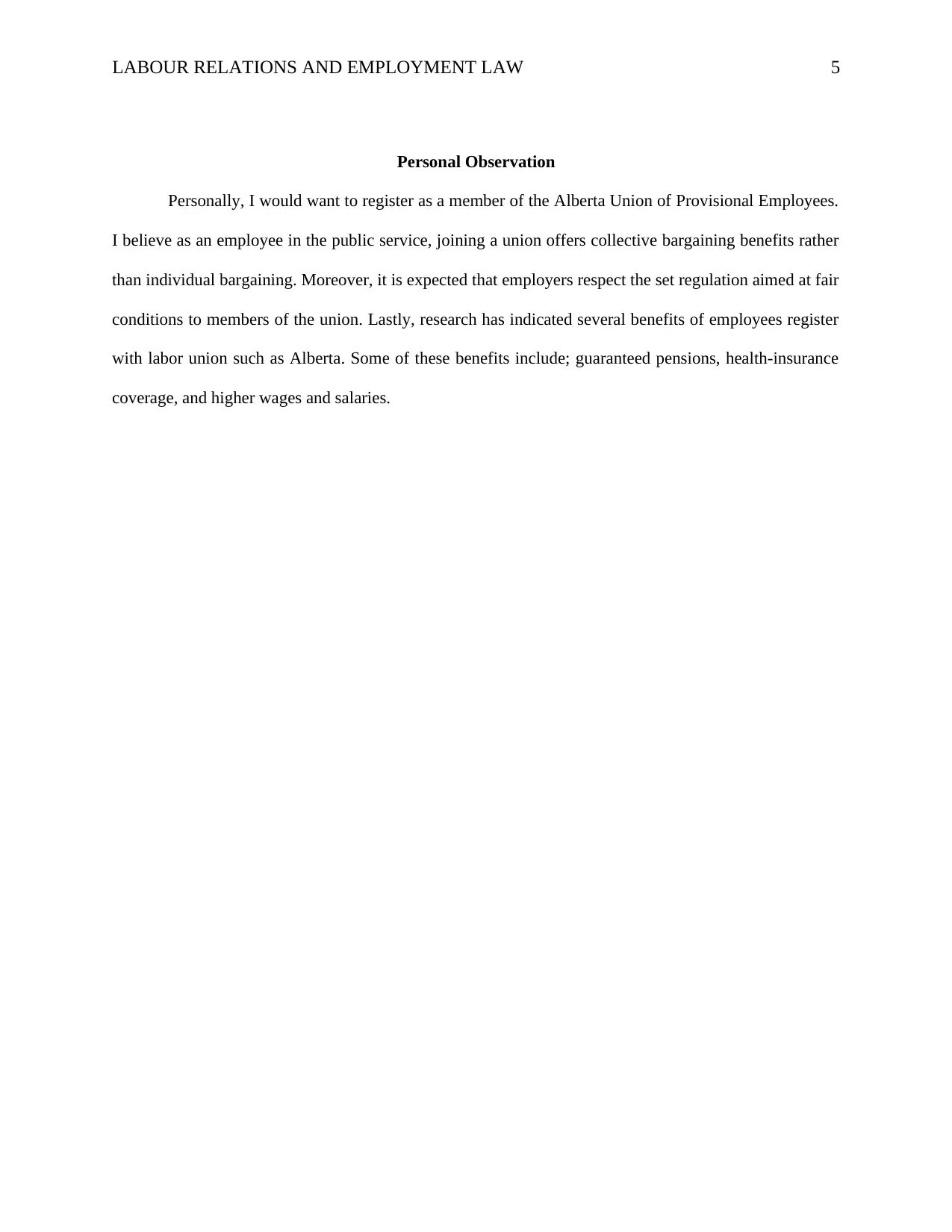
LABOUR RELATIONS AND EMPLOYMENT LAW 5
Personal Observation
Personally, I would want to register as a member of the Alberta Union of Provisional Employees.
I believe as an employee in the public service, joining a union offers collective bargaining benefits rather
than individual bargaining. Moreover, it is expected that employers respect the set regulation aimed at fair
conditions to members of the union. Lastly, research has indicated several benefits of employees register
with labor union such as Alberta. Some of these benefits include; guaranteed pensions, health-insurance
coverage, and higher wages and salaries.
Personal Observation
Personally, I would want to register as a member of the Alberta Union of Provisional Employees.
I believe as an employee in the public service, joining a union offers collective bargaining benefits rather
than individual bargaining. Moreover, it is expected that employers respect the set regulation aimed at fair
conditions to members of the union. Lastly, research has indicated several benefits of employees register
with labor union such as Alberta. Some of these benefits include; guaranteed pensions, health-insurance
coverage, and higher wages and salaries.
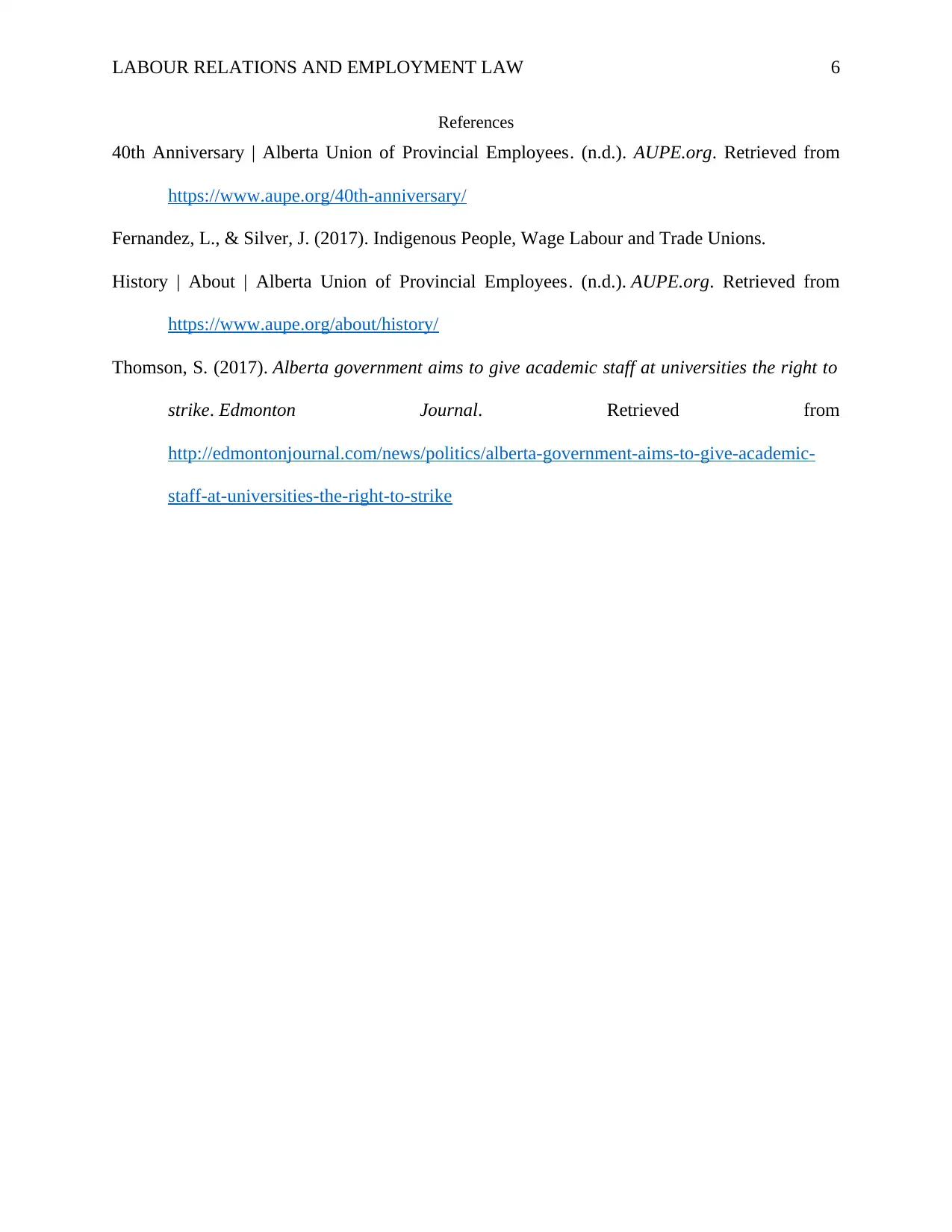
LABOUR RELATIONS AND EMPLOYMENT LAW 6
References
40th Anniversary | Alberta Union of Provincial Employees. (n.d.). AUPE.org. Retrieved from
https://www.aupe.org/40th-anniversary/
Fernandez, L., & Silver, J. (2017). Indigenous People, Wage Labour and Trade Unions.
History | About | Alberta Union of Provincial Employees. (n.d.). AUPE.org. Retrieved from
https://www.aupe.org/about/history/
Thomson, S. (2017). Alberta government aims to give academic staff at universities the right to
strike. Edmonton Journal. Retrieved from
http://edmontonjournal.com/news/politics/alberta-government-aims-to-give-academic-
staff-at-universities-the-right-to-strike
References
40th Anniversary | Alberta Union of Provincial Employees. (n.d.). AUPE.org. Retrieved from
https://www.aupe.org/40th-anniversary/
Fernandez, L., & Silver, J. (2017). Indigenous People, Wage Labour and Trade Unions.
History | About | Alberta Union of Provincial Employees. (n.d.). AUPE.org. Retrieved from
https://www.aupe.org/about/history/
Thomson, S. (2017). Alberta government aims to give academic staff at universities the right to
strike. Edmonton Journal. Retrieved from
http://edmontonjournal.com/news/politics/alberta-government-aims-to-give-academic-
staff-at-universities-the-right-to-strike
⊘ This is a preview!⊘
Do you want full access?
Subscribe today to unlock all pages.

Trusted by 1+ million students worldwide
1 out of 6
Related Documents
Your All-in-One AI-Powered Toolkit for Academic Success.
+13062052269
info@desklib.com
Available 24*7 on WhatsApp / Email
![[object Object]](/_next/static/media/star-bottom.7253800d.svg)
Unlock your academic potential
Copyright © 2020–2025 A2Z Services. All Rights Reserved. Developed and managed by ZUCOL.





